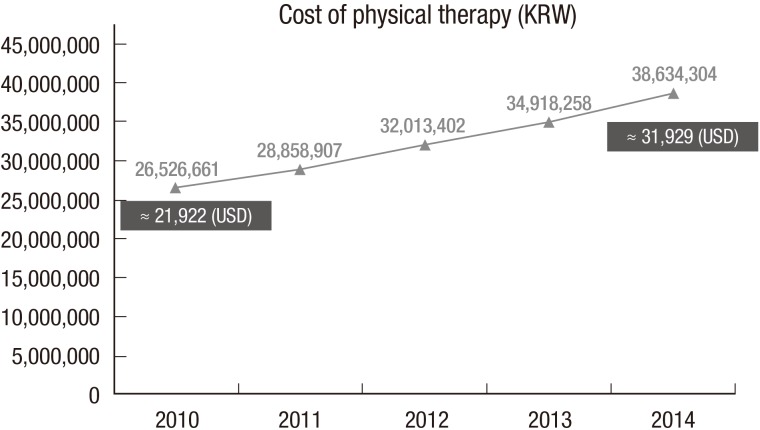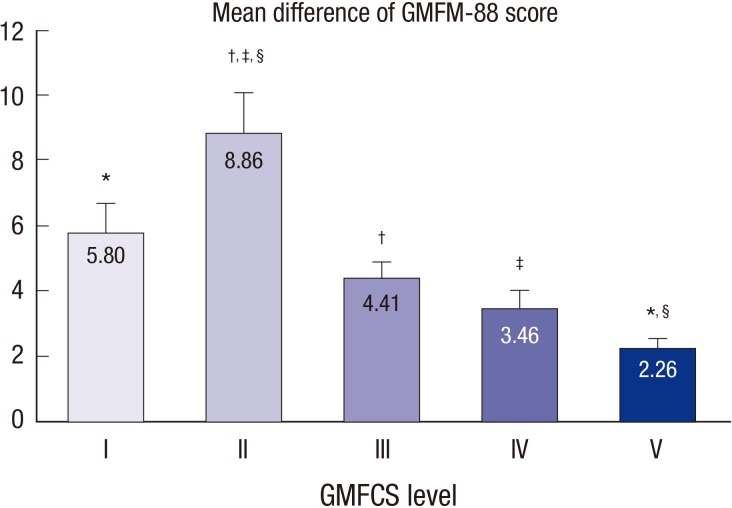J Korean Med Sci.
2017 May;32(5):873-879. 10.3346/jkms.2017.32.5.873.
Factors Influencing the Gross Motor Outcome of Intensive Therapy in Children with Cerebral Palsy and Developmental Delay
- Affiliations
-
- 1Department of Rehabilitation Medicine, St. Vincent's Hospital, College of Medicine, The Catholic University of Korea, Suwon, Korea. byhong@catholic.ac.kr
- 2Department of Dermatology, St. Vincent's Hospital, College of Medicine, The Catholic University of Korea, Suwon, Korea.
- KMID: 2375091
- DOI: http://doi.org/10.3346/jkms.2017.32.5.873
Abstract
- The study was designed to identify factors influencing the short term effect of intensive therapy on gross motor function in children with cerebral palsy or developmental delay. Retrospectively, total Gross Motor Function Measure-88 (GMFM-88) scores measured during the first and last weeks of intensive therapy were analyzed (n = 103). Good and poor responder groups were defined as those in the top and bottom 25% in terms of score difference, respectively. The GMFM-88 score increased to 4.67 ± 3.93 after 8 weeks of intensive therapy (P < 0.001). Gross Motor Function Classification System (GMFCS) level (I-II vs. IV-V; odds ratio [OR] = 7.763, 95% confidence interval [CI] = 2.177-27.682, P = 0.002) was a significant factor in a good response to therapy. Age (≥ 36 months; OR = 2.737, 95% CI = 1.003-7.471, P = 0.049) and GMFCS level (I-II vs. IV-V; OR = 0.189, 95% CI = 0.057-0.630, P = 0.007; and III vs. IV-V; OR = 0.095, 95% CI = 0.011-0.785, P = 0.029) were significantly associated with a poor response. GMFCS level is the most important prognostic factor for the effect of intensive therapy on gross motor function. In addition, age ≥ 36 months, is associated with a poor outcome.
MeSH Terms
Figure
Cited by 1 articles
-
The Role of Regular Physical Therapy on Spasticity in Children With Cerebral Palsy
Heewon Lee, Eun Kyung Kim, Dong Baek Son, Youngdeok Hwang, Joon-Sung Kim, Seong Hoon Lim, Bomi Sul, Bo Young Hong
Ann Rehabil Med. 2019;43(3):289-296. doi: 10.5535/arm.2019.43.3.289.
Reference
-
1. Spittle A, Orton J, Anderson PJ, Boyd R, Doyle LW. Early developmental intervention programmes provided post hospital discharge to prevent motor and cognitive impairment in preterm infants. Cochrane Database Syst Rev. 2015; CD005495. PMID: 26597166.2. Ministry of the Interior (KR). Resident registration demographics [Internet]. accessed on 2 January 2017. Available at http://rcps.egov.go.kr:8081.3. Rosenbaum P, Paneth N, Leviton A, Goldstein M, Bax M, Damiano D, Dan B, Jacobsson B. A report: the definition and classification of cerebral palsy April 2006. Dev Med Child Neurol Suppl. 2007; 109:8–14. PMID: 17370477.4. Aisen ML, Kerkovich D, Mast J, Mulroy S, Wren TA, Kay RM, Rethlefsen SA. Cerebral palsy: clinical care and neurological rehabilitation. Lancet Neurol. 2011; 10:844–852. PMID: 21849165.5. Arpino C, Vescio MF, De Luca A, Curatolo P. Efficacy of intensive versus nonintensive physiotherapy in children with cerebral palsy: a meta-analysis. Int J Rehabil Res. 2010; 33:165–171. PMID: 19910797.6. Odman P, Oberg B. Effectiveness of intensive training for children with cerebral palsy--a comparison between child and youth rehabilitation and conductive education. J Rehabil Med. 2005; 37:263–270. PMID: 16024485.7. Shamir M, Dickstein R, Tirosh E. Intensive intermittent physical therapy in infants with cerebral palsy: a randomized controlled pilot study. Isr Med Assoc J. 2012; 14:737–741. PMID: 23393711.8. Ustad T, Sorsdahl AB, Ljunggren AE. Effects of intensive physiotherapy in infants newly diagnosed with cerebral palsy. Pediatr Phys Ther. 2009; 21:140–148. PMID: 19440122.9. Sorsdahl AB, Moe-Nilssen R, Kaale HK, Rieber J, Strand LI. Change in basic motor abilities, quality of movement and everyday activities following intensive, goal-directed, activity-focused physiotherapy in a group setting for children with cerebral palsy. BMC Pediatr. 2010; 10:26. PMID: 20423507.10. Alotaibi M, Long T, Kennedy E, Bavishi S. The efficacy of GMFM-88 and GMFM-66 to detect changes in gross motor function in children with cerebral palsy (CP): a literature review. Disabil Rehabil. 2014; 36:617–627. PMID: 23802141.11. Hanna SE, Rosenbaum PL, Bartlett DJ, Palisano RJ, Walter SD, Avery L, Russell DJ. Stability and decline in gross motor function among children and youth with cerebral palsy aged 2 to 21 years. Dev Med Child Neurol. 2009; 51:295–302. PMID: 19391185.12. Palisano RJ, Cameron D, Rosenbaum PL, Walter SD, Russell D. Stability of the gross motor function classification system. Dev Med Child Neurol. 2006; 48:424–428. PMID: 16700931.13. Tsorlakis N, Evaggelinou C, Grouios G, Tsorbatzoudis C. Effect of intensive neurodevelopmental treatment in gross motor function of children with cerebral palsy. Dev Med Child Neurol. 2004; 46:740–745. PMID: 15540634.14. Trahan J, Malouin F. Intermittent intensive physiotherapy in children with cerebral palsy: a pilot study. Dev Med Child Neurol. 2002; 44:233–239. PMID: 11995891.15. Rahlin M. An individualized intermittent intensive physical therapy schedule for a child with spastic quadriparesis. Physiother Theory Pract. 2011; 27:512–520. PMID: 21568817.16. Bower E, Michell D, Burnett M, Campbell MJ, McLellan DL. Randomized controlled trial of physiotherapy in 56 children with cerebral palsy followed for 18 months. Dev Med Child Neurol. 2001; 43:4–15. PMID: 11201422.17. Russell DJ. Gross Motor Function Measure (GMFM-66 & GMFM-88) User's Manual. London: Mac Keith Press;2002.18. Rosenbaum PL, Walter SD, Hanna SE, Palisano RJ, Russell DJ, Raina P, Wood E, Bartlett DJ, Galuppi BE. Prognosis for gross motor function in cerebral palsy: creation of motor development curves. JAMA. 2002; 288:1357–1363. PMID: 12234229.19. Harries N, Kassirer M, Amichai T, Lahat E. Changes over years in gross motor function of 3-8 year old children with cerebral palsy: using the Gross Motor Function Measure (GMFM-88). Isr Med Assoc J. 2004; 6:408–411. PMID: 15274531.20. Novak I, McIntyre S, Morgan C, Campbell L, Dark L, Morton N, Stumbles E, Wilson SA, Goldsmith S. A systematic review of interventions for children with cerebral palsy: state of the evidence. Dev Med Child Neurol. 2013; 55:885–910. PMID: 23962350.21. Heinen F, Desloovere K, Schroeder AS, Berweck S, Borggraefe I, van Campenhout A, Andersen GL, Aydin R, Becher JG, Bernert G, et al. The updated European Consensus 2009 on the use of Botulinum toxin for children with cerebral palsy. Eur J Paediatr Neurol. 2010; 14:45–66. PMID: 19914110.22. Love SC, Valentine JP, Blair EM, Price CJ, Cole JH, Chauvel PJ. The effect of botulinum toxin type A on the functional ability of the child with spastic hemiplegia a randomized controlled trial. Eur J Neurol. 2001; 8(Suppl 5):50–58. PMID: 11851734.23. Desloovere K, Molenaers G, De Cat J, Pauwels P, Van Campenhout A, Ortibus E, Fabry G, De Cock P. Motor function following multilevel botulinum toxin type A treatment in children with cerebral palsy. Dev Med Child Neurol. 2007; 49:56–61. PMID: 17209978.24. Pin TW, Elmasry J, Lewis J. Efficacy of botulinum toxin A in children with cerebral palsy in Gross Motor Function Classification System levels IV and V: a systematic review. Dev Med Child Neurol. 2013; 55:304–313. PMID: 23095013.25. Copeland L, Edwards P, Thorley M, Donaghey S, Gascoigne-Pees L, Kentish M, Cert G, Lindsley J, McLennan K, Sakzewski L, et al. Botulinum toxin A for nonambulatory children with cerebral palsy: a double blind randomized controlled trial. J Pediatr. 2014; 165:140–146.e4. PMID: 24630348.26. Gabis LV, Tsubary NM, Leon O, Ashkenasi A, Shefer S. Assessment of abilities and comorbidities in children with cerebral palsy. J Child Neurol. 2015; 30:1640–1645. PMID: 25855688.27. Shevell MI, Dagenais L, Hall N. REPACQ Consortium. Comorbidities in cerebral palsy and their relationship to neurologic subtype and GMFCS level. Neurology. 2009; 72:2090–2096. PMID: 19528515.28. Hernandez MT, Sauerwein HC, Jambaqué I, De Guise E, Lussier F, Lortie A, Dulac O, Lassonde M. Deficits in executive functions and motor coordination in children with frontal lobe epilepsy. Neuropsychologia. 2002; 40:384–400. PMID: 11684172.29. Ruck-Gibis J, Plotkin H, Hanley J, Wood-Dauphinee S. Reliability of the gross motor function measure for children with osteogenesis imperfecta. Pediatr Phys Ther. 2001; 13:10–17. PMID: 17053645.30. Wright MJ, Halton JM, Martin RF, Barr RD. Long-term gross motor performance following treatment for acute lymphoblastic leukemia. Med Pediatr Oncol. 1998; 31:86–90. PMID: 9680932.
- Full Text Links
- Actions
-
Cited
- CITED
-
- Close
- Share
- Similar articles
-
- Efficacy of Intensive Neurodevelopmental Treatment for Children With Developmental Delay, With or Without Cerebral Palsy
- Developmental Delay of Language in Cerebral Palsy Children
- Motor delay: cerebral palsy
- Comparison of Speech-Language, Mental-Motor Development and Brain Radiologic Findings in Children with Cerebral Palsy and Other Delayed Development
- Gross Motor Function Outcome After Intensive Rehabilitation in Children With Bilateral Spastic Cerebral Palsy



